Blended Learning, meet Outdoor Education, you're such a wonderful fit...
As buzz words go in education, the 'blended learning' model has been steadily increasing as an accepted delivery within classroom education. Blended learning, a challenge to teacher-centered classrooms, is no more technical than it sounds, basically encompassing a fluid use of face-to-face, on-line and group collaboration of some sort. Outdoor education is a powerful example of experiential learning that is far too often compartmentalized as extra curricular. Praised by many; however, its value localized with wellness and character building.

As ironic as it seems, outdoor and experiential education stands to benefit by the current integration of technology. Teachers concerned with blending the classroom, as Cailin Tucker recently explained in a recent NPR article: "are using technology to replace elements of in-class instruction, classroom time can be leveraged to deepen learning. [Teachers] can embrace project-based learning and create student-centered classrooms to build on the work that’s completed online.”(1)
The key to blended learning is face time, more importantly, high quality face time: enter outdoor schools, retreats and expeditions. 'Off-site education' be it field studies, retreats, or outdoor schools have flourished over the previous fifty years as a fringe area with loyal advocates providing students with a powerful residential experience. Time spent in the field has always had a vision as part of a broader, comprehensive curriculum that includes time spent in class, project work with other schools - perhaps even in other cities and countries - part of a larger network, guest lectures and speakers, group work, and work done at home. The 'Connections Program' is a pioneer of proper blending and outdoor education. The program includes three components: pre-trip online work and related activities, a four day residential experience, and post-trip online work and final project. This program ensures students are in the same program at the same time from different schools, from various diverse (urban/rural) school boards, spanning the entire province of Alberta and allows students to obtain course credits upon completion.
What can this do to classrooms?
As anyone involved in experiential learning can attest to, when a group of students live together for a few days, learning is amplified. This form of pre-trip collaboration is commonplace now for students with others only in a digital platform. When students are then placed in an outdoor education realm (picture summer camp with teachers and professionals as instructors/counsellors) major outcomes of the common core/program of studies are attainable in an experiential method. The pre-trip focus of strictly 100% online turns into 100% offline. Then, an overarching factor is a tone of citizenship where among the trees, citizenship is modeled, transferred back into the digital realm upon return.
Sharing a meal community style, a chat to and from
activities, can lead students to the realization of the difference between
digital and face to face communication, the combination of digital
interactions with limbic resonance (serotonin released within the brain
during face to face communications) furthering transference. A key is not stopping at a 'one shot' experience such as The Urban School, a comprehensive blended school. This San Francisco institution most importantly creates a culture where students are "enthusiastic participants of their own education". A key fact in this is the realization, as Tucker explains: “Computer programs alone will not radically change the teaching paradigm...learning does not take place in the act of listening to (or viewing) information explained, but rather in the moments when we are asked to make sense of that information, to wrestle with ideas, to apply, evaluate, synthesize and use what we have learned to create something,”(1) or as Howard Gardner summarized in a 20 year-old interview, well before blended learning was associated with online technology stated:
"Consider kids who get A's in physics courses in good
high schools and colleges, who answer all the questions correctly on tests. If
they're put in a situation outside of class and asked to explain what's going
to happen—to draw a diagram, to make a prediction—they can't give the right
answer; in fact, the answers they give tend to be the same kinds of answers
you'd get from 5-year-olds, the kinds of explanations that were given in
Aristotle's time."(2)
Online education, in many cases at this point in time is nothing more than a set of electronic worksheets.
Despite this, students seem to be accepting, even pleased, with their online
experience. But what happens when the novelty wears off. "What happens when
technology becomes just another appliance – like the stove or washer?" provokes Steve Mashburn in his BYOT blog.
The impressive site: School day of the future where respected educators speak to a future vision, from the likes of Dr. Sugata Mitra and Curtis Wong. Blended and experiential education appear in every post, a strong sign of things to come.


Comments